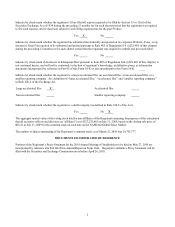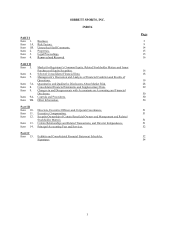Hibbett Sports 2010 Annual Report Download - page 15
Download and view the complete annual report
Please find page 15 of the 2010 Hibbett Sports annual report below. You can navigate through the pages in the report by either clicking on the pages listed below, or by using the keyword search tool below to find specific information within the annual report.11
In addition, we may be faced with significant excess inventory of some products and missed opportunities
for other products, which could decrease our profitability.
If we lose any of our key vendors or any of our key vendors fail to supply us with merchandise, we may not be
able to meet the demand of our customers and our net sales could decline.
We are a reseller of manufacturers’ branded items and are thereby dependent on the availability of key
products and brands. Our business is dependent to a significant degree upon close relationships with vendors and our
ability to purchase brand name merchandise at competitive prices. As a reseller, we cannot control the supply, design,
function or cost of many of the products we offer for sale. In addition, many of our vendors provide us with incentives,
such as return privileges, volume purchasing allowances and cooperative advertising. The loss of key vendor support
or decline or discontinuation of vendor incentives could have a material adverse effect on our business, financial
condition and results of operations. We cannot guarantee that we will be able to acquire such merchandise at
competitive prices or on competitive terms in the future. In this regard, certain merchandise that is in high demand may
be allocated by vendors based upon the vendors’ internal criterion which is beyond our control.
A disruption in the flow of imported merchandise or an increase in the cost of those goods may significantly
decrease our net sales and operating income.
We believe many of our largest vendors source a substantial majority of their products from foreign
countries. Imported goods are generally less expensive than domestic goods and indirectly contribute significantly
to our favorable profit margins. We may experience a disruption or increase in the cost of imported vendor products
at any time for reasons beyond our control. If imported merchandise becomes more expensive or unavailable, the
transition to alternative sources by our vendors may not occur in time to meet our demands or the demands of our
customers. Products from alternative sources may also be more expensive than those our vendors currently import.
Risks associated with reliance on imported goods include:
disruptions in the flow of imported goods because of factors such as:
raw material shortages, work stoppages, strikes and political unrest;
problems with oceanic shipping, including blockages at U.S. or foreign ports;
economic crises and international disputes; and
increases in the cost of purchasing or shipping foreign merchandise resulting from:
foreign government regulations;
changes in currency exchange rates or policies and local economic conditions; and
trade restrictions, including import duties, import quotas or loss of “most favored nation” status with
the United States.
In addition, to the extent that any foreign manufacturer from whom our vendors are associated may directly
or indirectly utilize labor practices that are not commonly accepted in the United States, we could be affected by any
resulting negative publicity. Our net sales and operating income could decline if vendors are unable to promptly
replace sources providing equally appealing products at a similar cost.
Problems with our information system software could disrupt our operations and negatively impact our financial
results and materially adversely affect our business operations.
The efficient operation of our business is dependent on the successful integration and operation of our
information systems. In particular, we rely on our information systems to manage effectively our sales, distribution,
merchandise planning and replenishment, to process financial information and sales transactions and to optimize our
overall inventory levels. Most of our information systems are centrally located at our headquarters, with offsite
backup at other locations. Our systems, if not functioning properly, could disrupt our ability to track, record and
analyze sales and inventory movement and could cause disruptions of operations, including, among other things, our
ability to process and ship inventory, process financial information including credit card transactions, process
payrolls or vendor payments or engage in other similar normal business activities. Any material disruption,
malfunction or any other similar problem in or with our information systems could negatively impact our financial
results and materially adversely affect our business operations.
Pressure from our competitors may force us to reduce our prices or increase our spending, which would lower
our net sales and operating income.
The business in which we are engaged is highly competitive. The marketplace for sporting goods remains
highly fragmented as many different retailers compete for market share by utilizing a variety of store formats and
merchandising strategies. We compete with national chains that focus on athletic footwear, local sporting goods stores,
department and discount stores, traditional shoe stores and mass merchandisers and, on a limited basis, national
sporting goods stores. Many of our competitors have greater financial resources than we do. In addition, many of our
competitors employ price discounting policies that, if intensified, may make it difficult for us to reach our sales goals
























